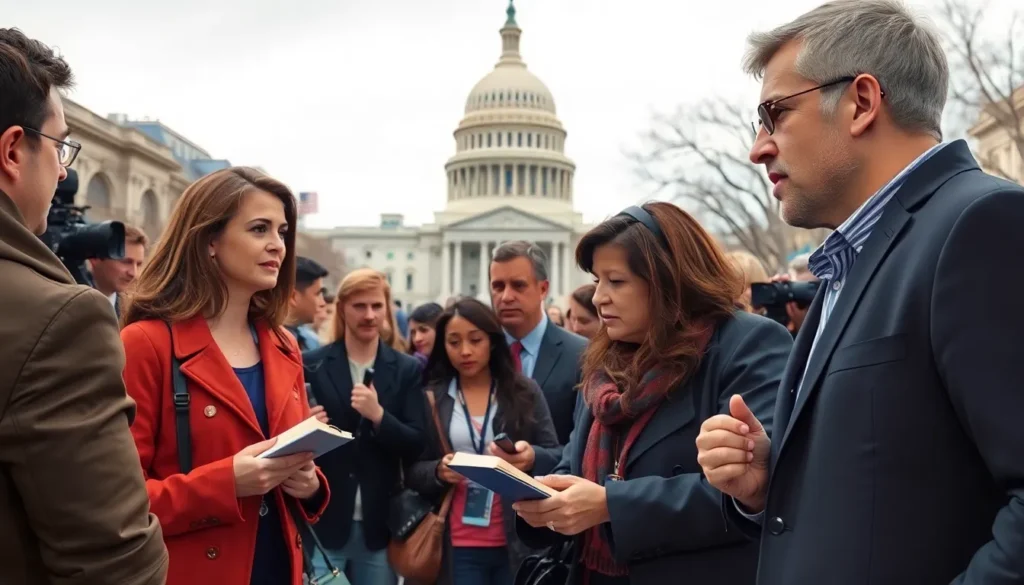Table of Contents
ToggleIn the world of journalism and writing, clarity is king, and when it comes to the specifics of Washington, D.C., following the AP Style is like having your own personal tour guide through the city’s intricate maze of rules. Whether it’s the proper way to reference the Capitol or the nuances of political titles, mastering this style can elevate any piece from mediocre to magnificent.
Imagine trying to navigate the bustling streets of D.C. without a map—confusing, right? That’s how writers feel when they ignore AP Style. With a sprinkle of humor and a dash of professionalism, this guide will help writers conquer the quirks of Washington, D.C., ensuring their work is both polished and precise. Let’s dive into the essential tips that’ll make writing about the nation’s capital as smooth as a well-crafted speech from the Lincoln Memorial.
Overview of Washington DC AP Style
Understanding the nuances of AP Style in Washington, D.C. is essential for clear communication. This style provides crucial guidelines for writing about the nation’s capital.
Importance of AP Style in Journalism
AP Style fosters clarity, accuracy, and consistency in journalism. Clarity helps readers grasp content quickly, while accuracy ensures that facts remain reliable. Following this style enhances the professionalism of news articles. Consistency across publications strengthens credibility. Writers familiar with AP Style reduce misunderstandings. Journalists covering Washington’s intricate political landscape benefit significantly from these guidelines.
Key Differences in Style Guide
Writers must note specific differences between AP Style and other style guides. For example, the use of “D.C.” instead of “DC” maintains clarity, adhering to proper noun conventions. Titles such as “Senator” or “Representative” are capitalized when used before a name, emphasizing respect and formality. Distinctions exist in formatting dates, addresses, and numbers, where AP Style generally opts for simplicity. Many journalists prefer AP Style for its straightforward approach. Adapting to these differences strengthens the effectiveness of communication in political writing.
Capitalization Rules

Capitalization rules in AP Style govern how to present various terms in Washington, D.C. Proper attention to these guidelines contributes to clarity and professionalism in writing.
Proper Nouns and Titles
Proper nouns require capitalization, including specific places, organizations, and formal titles. Titles preceding a person’s name should be capitalized, such as “Senator,” “Governor,” or “President.” When used alone or following a name, titles remain lowercase. For instance, “President Biden” is correct, while “the president” is not capitalized. Likewise, capitalize agency names like “Environmental Protection Agency.” City and state names, including “Washington” and “D.C.,” also demand proper noun treatment, contributing to precise identification.
Common Exceptions
Common exceptions to capitalization rules exist. Lowercase terms like “city” or “county” when referring to them generically, such as “the city of Washington.” Certain descriptive titles in sentences may also remain lowercase unless part of a formal name. For example, write “the president of the United States” instead of capitalizing “president.” The word “federal” stays lowercase unless part of an official title like “Federal Bureau of Investigation.” Recognizing these exceptions helps maintain accuracy and readability in communication.
Punctuation Guidelines
Punctuation plays a crucial role in ensuring clarity and precision in writing about Washington, D.C. Following AP Style guidelines enhances the readability of content related to the nation’s capital.
Use of Commas
Commas serve to separate elements in a series, clarifying complex lists. Use commas before conjunctions in a series, such as “apples, oranges, and bananas.” When addressing cities and states, a comma follows the city, as in “Washington, D.C.” Place commas between independent clauses when using coordinating conjunctions. Avoid adding unnecessary commas that may confuse readers. In dates, the year follows a comma after the day, as in “April 5, 2023.” Be attentive to these rules to maintain effective communication.
Quotation Marks and Italics
Quotation marks should enclose direct quotes and titles of short works like articles and songs. For example, write “The Capital Insider” when referencing an article title. Italics are appropriate for longer works, including books and newspapers. The phrase The Washington Post should be italicized to differentiate it. Use quotation marks for punctuation within quotes, placing them correctly around punctuation marks like periods and commas. Following these guidelines underscores the professionalism of journalistic writing about Washington, D.C.
Abbreviations and Acronyms
Abbreviations and acronyms play a vital role in writing about Washington, D.C. Understanding when to use them enhances clarity and ensures adherence to AP Style.
When to Use Abbreviations
Abbreviations should appear in a text when they improve readability without causing confusion. For instance, commonly accepted terms like “U.S.” for United States or “D.C.” for District of Columbia can streamline communication. Avoid using abbreviations on first reference unless they are widely recognized. Write out the full name initially, followed by the abbreviation in parentheses. Journalists should use abbreviations for titles of government agencies, such as EPA for Environmental Protection Agency or FBI for Federal Bureau of Investigation, after fully introducing them. Clarity remains paramount; therefore, always consider the audience’s familiarity with specific abbreviations.
Standard Acronyms for Washington DC
Standard acronyms carry particular significance in Washington, D.C. First, notable examples include “NATO” for North Atlantic Treaty Organization and “HHS” for the Department of Health and Human Services. Understanding these acronyms enhances communication in political contexts, given their frequent usage. For ease, include an explanation when introducing less-known acronyms. Abbreviate widely understood terms like “GOP” for Grand Old Party or “BID” for Business Improvement District after initial full reference. Journalists should remain consistent with acronym use throughout the article to maintain continuity and ensure readers easily follow the information.
Writing Dates and Times
Clarity in presenting dates and times adheres to AP Style, ensuring effective communication. Proper formatting establishes consistency and aids reader comprehension.
Formatting Dates
Dates follow a specific format in AP Style. Use numerals for days, followed by the month in lowercase. For example, write “March 4” instead of “March fourth.” When including a year, place it after the month, separated by a comma, as in “March 4, 2023.” Avoid abbreviating months when using a specific date, except for the months of Jan., Feb., Aug., Sept., Oct., Nov., and Dec. When mentioning just the month and year, omit the day, as in “March 2023.”
Mastering AP Style is essential for anyone writing about Washington, D.C. It not only enhances the clarity and professionalism of content but also ensures that readers can easily navigate complex political topics. By following the specific guidelines for capitalization punctuation and abbreviations, writers can effectively communicate important information without confusion.
Understanding these nuances allows journalists to maintain accuracy and consistency in their work. This attention to detail ultimately reflects the quality of their writing and the credibility of their reporting. Embracing AP Style is a step toward elevating journalistic standards in the nation’s capital.




